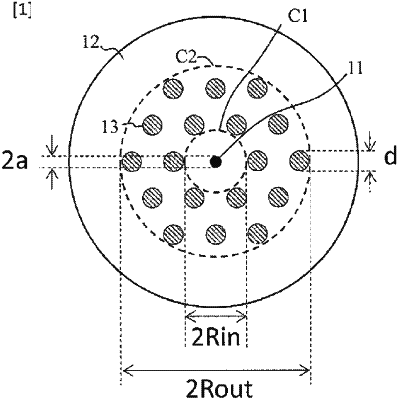| CPC G02B 6/02347 (2013.01) [G02B 6/02361 (2013.01); G02B 6/02366 (2013.01); G02B 6/032 (2013.01); G02B 6/036 (2013.01)] | 3 Claims |

|
1. A hole-assisted fiber comprising:
a core portion having a uniform optical refractive index, the core portion having a radius a;
a cladding portion having a uniform optical refractive index, the cladding portion being radially divided into first, second, and third ring-shaped layers, the first ring-shaped layer circularly surrounding the core portion, the second ring-shaped layer circularly surrounding the first ring-shaped layer, the third ring-shaped layer circularly surrounding the second ring-shaped layer; and
a plurality of air holes arranged only in the second ring-shaped layer along a longitudinal direction of the hole-assisted fiber, each of the plurality of air holes having a diameter d that is larger than a diameter 2a of the core portion, wherein
a center-to-center spacing between adjacent two air holes of the plurality of air holes is a sum of a radius Rin of an outer circumference of the first ring-shaped layer inscribing air holes of the plurality of air holes and a radius d/2 of an air hole of the plurality of air holes,
an outer circumference of the second ring-shaped layer circumscribes the air holes of the plurality of air holes,
Rin/a is in a range of 3 to 7.5,
in a cross section of the hole-assisted fiber, an air hole occupancy ratio S is represented by an expression of 0.001×exp(Rin/a/1.66)+0.19≤S≤−9.60×exp(−Rin/a/0.65)+0.30, and
the air hole occupancy ratio S is a ratio of a sum of areas of the plurality of air holes to an area of the second ring-shaped layer.
|